Customized Stop-the-Slip Solutions
For Your Unique Conditions
Your Stop-the-Slip Solutions Graded:
Handi-Treads: A-
Handi-Treads are the most effective, long-lasting solution for minimizing the risk of slips and falls on exterior brick or stone stairs. The raised traction buttons of the aluminum tread are uniquely self-cleaning. When you step on the rigid raised aluminum buttons, the layer of moisture, frost or up to an inch of snow is pushed away creating solid contact between the tread and sneaker, shoe, or boot.
Installation of the aluminum Handi-Treads on brick or stone is straight-forward and simple. In contrast to the multi-task effort required to install traction tape or grit paint, there’s no need for time-consuming surface preparation prior to installation. Once installed, no maintenance is required for Handi-Treads, which are guaranteed to last a lifetime in residential environments. You will need to use concrete lags, which can be found here, to secure the aluminum treads.
If you live in an area where it snows, you’ll find that you can use a snow shovel on your Handi-Treads without fear of damage to the treads. Grit tape, grit paint and most mats can be damaged by a snow shovel.
Because Handi-Treads are a lifetime solution with once-and-done installation and maintenance, their initial cost is higher. When calculated over a three to five year performance period however, the investment in Handi-Treads is often the most-cost effective solution.

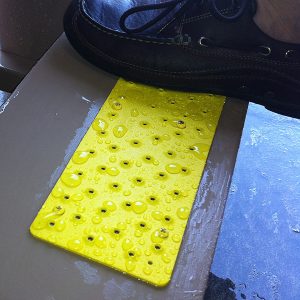

Total Score: A-
Effectiveness: A
Installation & Maintenance: A
Durability: A
Initial Price: C
Long-Term Value: A
Non-Slip Grit Tape: D-
Anti-slip tape can be used on smooth, flat stone steps as a short-term fix to reduce slips and falls. Grip tape will not adhere well to brick surfaces even if applied to the smooth side of the brick. In addition, the cement between the bricks is porous and absorbs and expels moisture which precludes the use of tape.
In those stone applications where the tape can be successfully placed, rain and frost are easily dealt with by grit embedded into the tape, provided that the tape has adhered to the surface. There is no tape-based adhesive that can realistically stand up to rain, snow and the inevitable heat and thaw cycles, no matter the application.
Before installing grit tape, it’s important that the stone surface is clean, dry and in good shape. There’s no maintenance that can or should be done to the tape other than to be very careful of the edges and corners. Once a corner or edge begins to peel, the grip tape will quickly deteriorate. In snowy weather you must brush the snow off grit tape with a broom. The use of a snow shovel will peel up the tape almost immediately.
With a lifespan on outdoor stone steps of six months to a year, grit tape can be an inexpensive temporary solution.

Total Score: D-
Effectiveness: D
Installation & Maintenance: F
Durability: F
Initial Price: B
Long-Term Value: F
Rubber or Door Mat Style Treads: C-
While door mat style and rubber treads can be successfully installed on brick and stone stairs, their lack of structural rigidity can lead to significant problems in a relatively short amount of time. The only safe way to affix the rubber or fiber treads to brick or stone is with the use of lags and screws. If any one one of the lags gives way, that corner of the door mat or rubber tread can pop up, creating a slip-and-fall hazard itself. The lack of structural rigidity also encourages lags to become loose from the brick, something not suffered by the structural integrity of Handi-Treads.
Both rubber and door mat style treads can be effective in wet and winter weather if they are kept free of snow. Care must be taken when using a snow shovel with rubber treads as even a plastic blade can cut the rubber. Snow can be removed from door mat style treads with a shovel fairly easily as long as care is taken not to lodge the shovel under the edge of the tread.
Some rubber stair treads suggest that it is acceptable to use adhesive caulk to secure rubber or door mat treads to brick. We think this is poor advice as no typical exterior adhesive can adequately adhere to brick which, by its very nature, breathes, expands and contracts.
There is no maintenance that can be performed on rubber or door mat style stair treads. Deeply patterned or cut treads collect dirt in the gaps and must be cleaned using a leaf blower.
Depending upon thickness and quality of the material, you can expect rubber or door mat style treads to last 2 to 4 years.
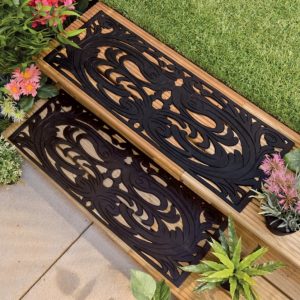

Total Score: C-
Effectiveness: C
Installation & Maintenance: D
Durability: C
Initial Price: B
Long-Term Value: C
Grit Paint: C+
Grit paint can reduce slipperiness on brick or stone stairs, but the paint will cover the brick or stone aesthetic completely. Grit paint can improve the safety of a deck or porch if (1) it’s a high-quality enamel or epoxy paint, (2) it’s applied meticulously, and (3) it’s maintained properly.
Like grit tape, non-slip paints include an aggregate that creates traction. The best anti-slip paints contain aluminum oxide or carborundum that, while encapsulated in the paint, creates a rough, slip resistant surface. We rate the effectiveness of grip paint very high for wet weather, frost, and a dusting of snow.
Anti-slip paints on exterior surfaces are, by and large, maintenance free. However, if you live where it snows you need to be very careful not to aggressively shovel the stairs painted with grit paint. While the epoxy or enamel coating is durable under normal foot traffic, it’s no match for an aluminum or even a plastic snow shovel. Once you start to scrape way the thin paint layer covering the aggregate, the system will quickly degrade.
The cost of a high-quality grit paint can run between $60 and $120 a gallon. In addition, you’ve got the consumable cost of paint brushes or rollers, trays, sandpaper, masking tape, and drop cloths. When all costs are factored, and depending upon the number of stairs, grit paint can be one of the most expensive solutions.
Grit paint, properly applied, can be expected to last 2 to 4 years on brick and stone steps.
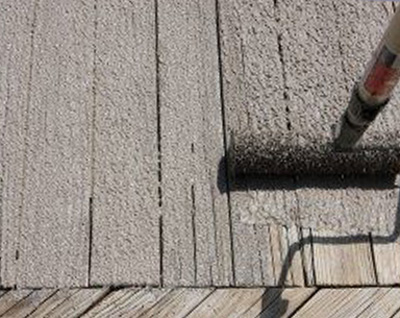
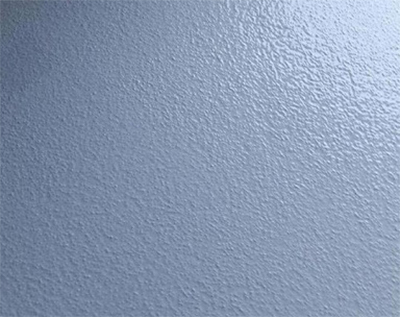
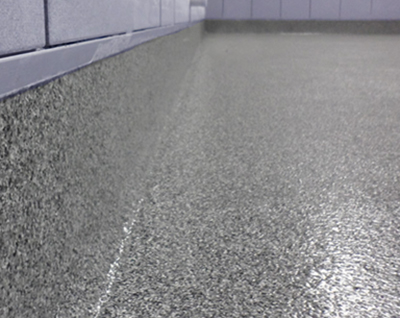
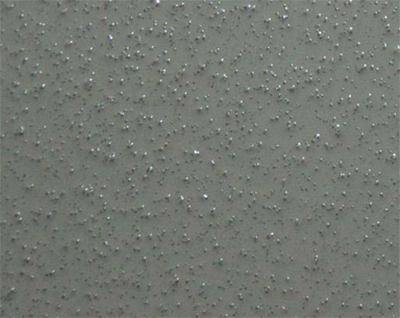
Total Score: C+
Effectiveness: B
Installation & Maintenance: D
Durability: C
Initial Price: C
Long-Term Value: B
